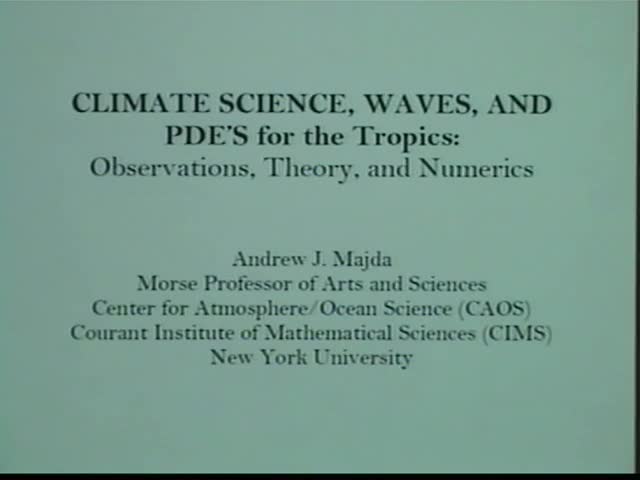Tutorial Lecture: Climate Science, Waves and PDE's for the Tropics
Presenter
April 11, 2011
Keywords:
- Geophysical, flow
MSC:
- 76E20
Abstract
Geophysical flows are a rich source of novel problems for applied mathematics and the contemporary theory of partial differential equations. The reason for this is that many physically important geophysical flows involve complex nonlinear interaction over multi-scales in both time and space so developing simplified reduced models which are simpler yet capture key physical phenomena is of central importance. In mid-latitudes, the fact that the rotational Coriolis terms are bounded away from zero leads to a strict temporal frequency scale separation between slow potential vorticity dynamics and fast gravity waves; this physical fact leads to new theorems justifying the quasi-geostrophic midlatitude dynamics even with general unbalanced initial data for both rapidly rotating shallow water equations and completely stratified flows.
At the equator, the tangential projection of the Coriolis force from rotation vanishes identically so that there is no longer a time scale separation between potential vortical flows and gravity waves. This has profound consequences physically that allow the tropics to behave as a waveguide with extremely warm surface temperatures. The resulting behavior profoundly influences longer term mid-latitude weather prediction and climate change through hurricanes, monsoons, El Nino, and global teleconnections with the mid-latitude atmosphere. How this happens through detailed physical mechanisms is one of the most important contemporary problems in the atmosphere-ocean science community with a central role played by nonlinear interactive heating involving the interaction of clouds, moisture, and convection. The variable coefficient degeneracy of the Coriolis term at the equator alluded to earlier leads to both important new physical effects as well as fascinating new mathematical phenomena and PDE’s. In this equatorial context, new multi-scale reduced dynamical PDE models are even relatively recent in origin.
After a brief discussion of the observational record as background, this lecturer surveys the remarkable new hyperbolic systems that have emerged recently in applications including their physical properties, applied mathematical and rigorous mathematical theory. These last topics include novel relaxation limits for climate models with active moisture and new singular limits for hyperbolic PDE’s with variable coefficients. All of the references in this lecture can be found at .http://www.math.nyu.edu/faculty/majda/.
